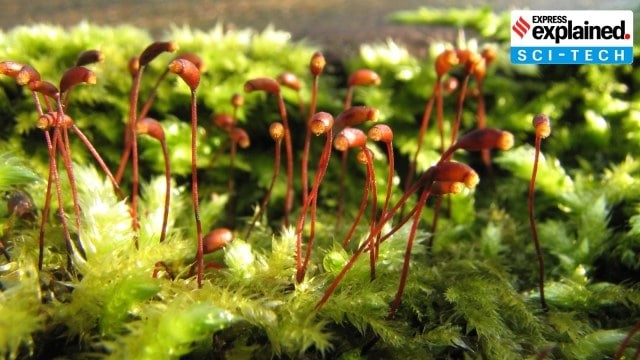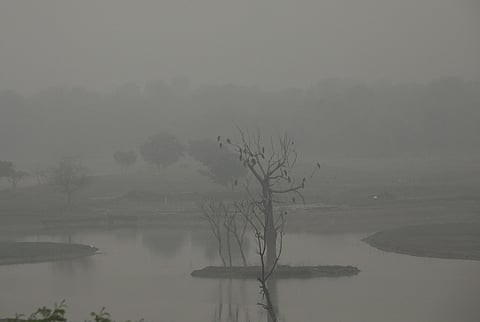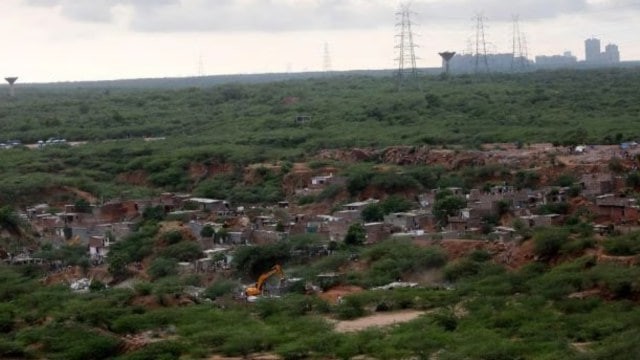



Moss spores have demonstrated the ability to survive prolonged exposure to space conditions, including vacuum, cosmic radiation, and temperature extremes, while remaining capable of reproduction. This remarkable resilience highlights the potential of moss in supporting sustainable life-support systems, oxygen generation, and soil formation for future extraterrestrial habitats, while also advancing our understanding of life's limits and interplanetary survival.

Copyright infringement not intended
Picture Courtesy: Indian Express
A team of scientists has found that moss can survive a prolonged trip to space. As part of a study, a handful of moss spores survived nine months exposed to low-orbit conditions, with 80% of them still able to reproduce once back in a lab on Earth.
|
Must Read: Syntrichia caninervis | Bryum Bharatiensis | TAKAKIA | |
Nature:
Mosses are simple, non-vascular land plants that reproduce using spores instead of seeds. They fall under the plant group Bryophyta, which represents some of the earliest plant lineages to colonise terrestrial environments.
Background:
They are considered among the oldest land plants, with their origins tracing back hundreds of millions of years. Fossil records from periods such as the Permian, and later from the Paleogene and Neogene, show that mosses have had a long and stable evolutionary presence, indicating their exceptional adaptability.
Distribution:
Mosses are found across almost all climatic regions of the world, from polar ice fields to tropical forests. Their absence in marine saltwater environments is notable, but they thrive in nearly every other habitat, including freshwater systems, rocks, tree trunks, and soil surfaces.
Habitats:
Typically associated with moist, shaded, and nutrient-poor locations, mosses are highly resilient and capable of establishing themselves in environments where many other plants cannot survive—such as Antarctic landscapes, volcanic terrains, deserts, and exposed rock surfaces. Their ability to tolerate dehydration, freeze-thaw cycles, and nutrient scarcity helps them act as pioneer species.
Diversity:
Globally, more than ten thousand species of mosses have been identified. These are broadly grouped into three major categories—
This diversity allows mosses to occupy a wide range of ecological roles.
Reproduction:
Mosses propagate through spores, which function much like seeds in higher plants but are produced without flowers or fruits. These spores are highly resistant and allow mosses to disperse over large distances and establish quickly in new environments.
Conclusion:
The survival of moss spores in space shows that simple plant life can tolerate extreme extraterrestrial conditions, broadening our understanding of life’s resilience and offering practical pathways for future space habitats. It strengthens astrobiological theories, supports bioregenerative life-support systems, and informs safer planetary exploration and settlement strategies.
Source: Indian Express
|
Practice Question Q. The recent experiments on Physcomitrium patens spores surviving prolonged exposure to space have significant implications for space exploration and astrobiology. Discuss (150 words) |
Moss spores have multiple protective layers, can survive desiccation, extreme temperatures, radiation, and lack of gravity, allowing them to endure prolonged exposure to space conditions.
Experimental data suggests moss spores can survive at least nine months in low-Earth orbit, and projections indicate survival could extend to around 15 years.
Moss spores can be used in life-support systems for oxygen generation, humidity control, and soil formation, supporting sustainable habitats on the Moon, Mars, or other planets.







© 2025 iasgyan. All right reserved